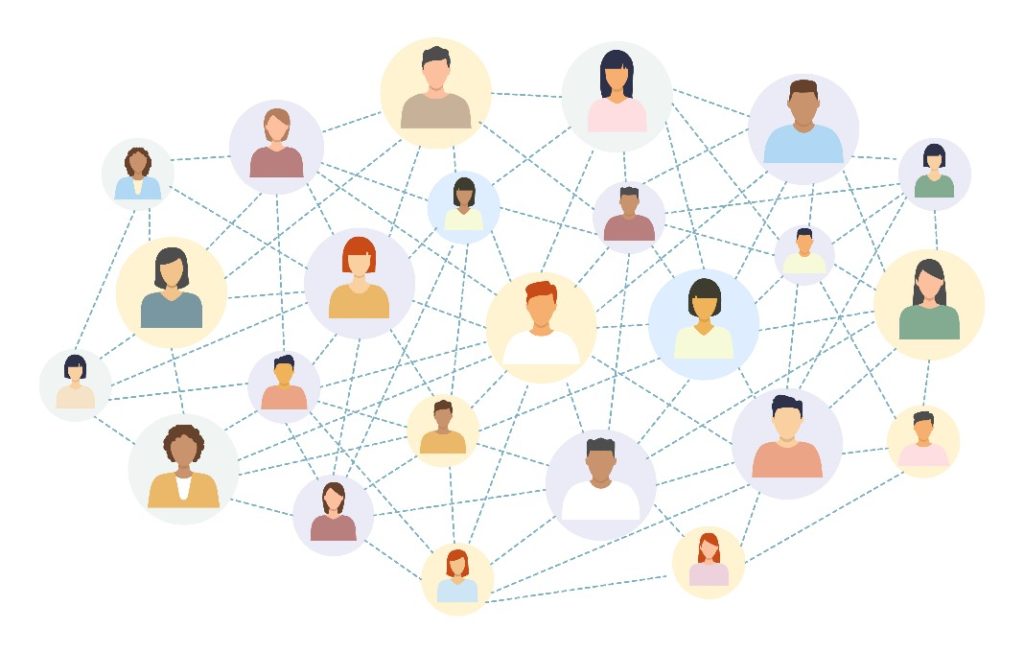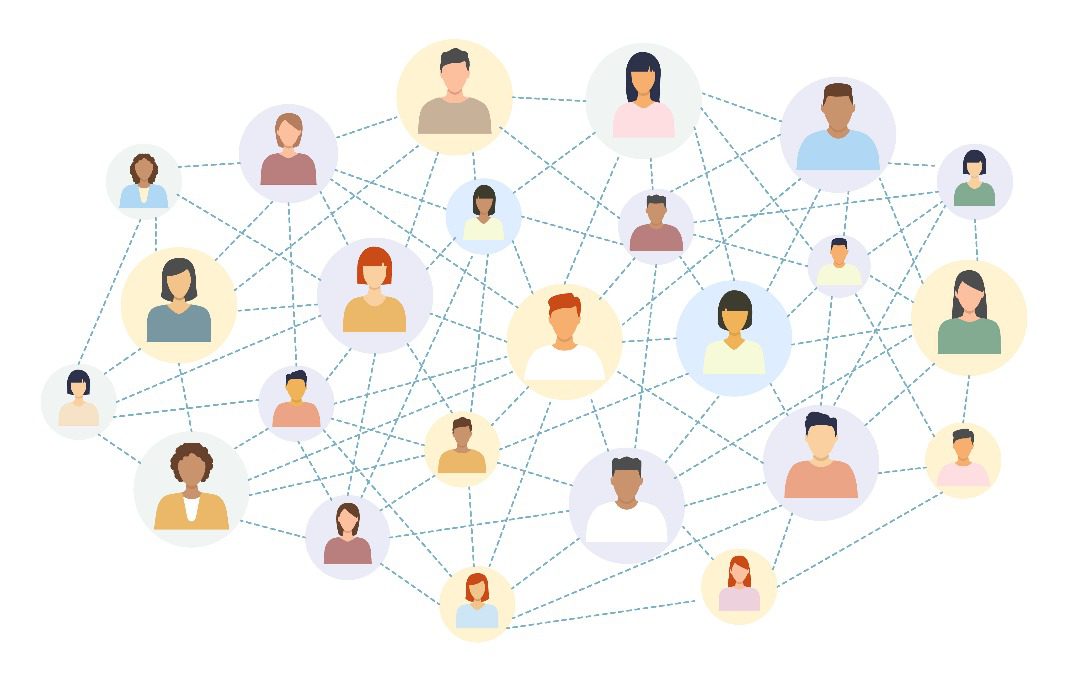 In today’s hyperconnected age, we’re all familiar with the concept of networks, the webs of relationships that connect people or things. Networks influence who you are connected to, where you get your information, and how work gets done. Networks are “intricately intertwined with an organization’s performance, the way it develops and executes strategy, and its ability to innovate,” write Rob Cross and Andrew Parker in The Hidden Power of Social Networks. Their research shows that “well managed network-connectivity is critical to performance, learning and innovation.”
In today’s hyperconnected age, we’re all familiar with the concept of networks, the webs of relationships that connect people or things. Networks influence who you are connected to, where you get your information, and how work gets done. Networks are “intricately intertwined with an organization’s performance, the way it develops and executes strategy, and its ability to innovate,” write Rob Cross and Andrew Parker in The Hidden Power of Social Networks. Their research shows that “well managed network-connectivity is critical to performance, learning and innovation.”
What many don’t realize, however, is that networks can be deliberately organized to forge connections across divides, spread information and learning, and spark collaborative action. When networks form to address complex social or environmental issues, they receive a special name: impact networks. This type of network brings individuals and organizations together to share information and coordinate actions to tackle issues that hierarchies are ill-suited to address. As a result, they can improve coordination across multiple stakeholder groups, and provide organizations with a means to unlocking the creativity and engagement of their people.
When Michiel Bakker first arrived at Google as the leader of the Food team, he found it to be a very inward-looking organization. To make a broader impact on some of the biggest, most complex issues that Google cared about, Bakker saw the need to foster connections across the Google system as well as with people from the outside. With Bakker’s leadership, Google launched the Food Lab in 2012 to address critical food system issues and to inspire its employees to develop more sustainable lifestyles. Since then, the Food Lab has brought people together from all levels of the Google organization, along with external experts and leaders. Convening twice per year, they apply their collective knowledge to key focus areas, including moving food culture toward a more plant-forward diet, increasing transparency in the food system, and reducing plastic waste.
The Food Lab has facilitated new relationships across the Google system, with participating employees coming from many different departments and all levels of the organization, excited to have the chance to contribute to an issue they care deeply about. The Food Lab has also shaped Google’s strategic work. “When you bring together multiple points of view, you come up with solutions you never would have thought of alone,” shares Bakker. “The Food Lab has provided a much deeper understanding of the challenges and the opportunities, while leading to partnerships that would not have existed prior.”
While the “why” (a network’s purpose) and the “what” (a network’s actions) differ widely from one impact network to another, the “how” (a network’s formation) is remarkably consistent. Forming, cultivating, and sustaining an impact network involves five core activities, referred to as the “Five Cs”:
- Clarify the network’s purpose and principles
- Convene the people
- Cultivate trust
- Coordinate members’ actions
- Collaborate for change
These five activities are dynamic and interdependent. Never fully complete and not strictly linear, they loop back and forth on each other as the network evolves, and they’ll be revisited over and over throughout a network’s life cycle.
Clarify the Network’s Purpose and Principles
A network’s purpose is its reason for being; it’s what inspires people to join and contribute their time and energy. Clarifying a common purpose is an essential early step in forming an impact network. Due to their self-organizing nature, impact networks can’t be controlled. They can, however, be oriented toward a shared purpose, and this shared purpose is how networks stay coherent—even as they grow.
As a network clarifies its purpose, articulating its shared principles is also helpful. Principles are fundamental beliefs about how network members intend to conduct themselves and work together in pursuit of the network’s purpose. They guide members’ behavior and decision-making by linking values with action.
Together, purpose and principles create a foundation for vibrant, and coherent, self-organization.
Try this tip: Use this exercise to uncover the personal motivations—the “whys”—that inspire people to join a network.
Convene the People
Fundamentally, cultivating a network is about bringing people together to create a more interconnected whole. Connections are central to what makes networks work.
There are many ways to create connections: one-on-one, through group calls, through online communication platforms, and more. However, one method consistently stands above the rest: convening your people.
Convening is the art of gathering people together simultaneously, whether in person or online. Successful convenings create a generative space where people interact, think, talk, and collaborate in new ways. Convenings transform members’ relationships and create moments where participants envision and build their future together, making them critical touchstones for emerging and mature networks alike.
Try this tip: Use this list of questions to help members open up and connect at your next convening.
Cultivate Trust
Impact networks are only as strong as the relationships that hold them together—and these relationships influence nearly everything a network aims to achieve, including how information is shared, how decisions are made, and how work gets done.
When relationships deepen to a point of mutual confidence—when two people feel they can count on each other to act in service to the network’s purpose—we call that trust. Trust is the fundamental element that establishes a culture of openness, commitment, and collaboration.
Importantly, trust shouldn’t be confused with people liking each other or agreeing. To work together, people don’t need to like one another. And they certainly don’t need to agree on every issue. Instead, trust within an impact network is about finding common ground and working together to achieve mutual goals.
Although it’s widely accepted that trust helps people collaborate, a network may be tempted to quickly “get to the action” and let relationships develop naturally over time. However, we’ve consistently found that trust is the single most important factor behind successful impact networks; networks move at the speed of trust. Therefore, trust should be deliberately nurtured within a network from day one.
Try this tip: Use this group exercise to build trust, form deeper relationships, and set the stage for courageous conversations.
Coordinate Members’ Actions
Impact networks aren’t just about relationships; they’re also about flows—getting information, knowledge, and resources to where they’re needed most.
When flows are accelerated across networks, people are better able to coordinate their actions: sharing new or promising practices with one another, reducing unnecessary duplication, and finding quick wins that demonstrate the immediate value of the network.
Try this tip: Use this exercise to quickly coordinate your members’ needs and what they’re interested in exploring.
Collaborate for Change
Increasing connections and flows across networks creates many positive benefits. But if the goal of your network is to bring about far-reaching, systemic change, you’ll need to dive deeper and explore possible leverage points. These are the places in a system where, as environmental advocate Donella Meadows once put it, “a small shift in one thing can produce big changes in everything.”
However, to create big changes in an equally big system, a network must first explore the system from many different perspectives. People and organizations are usually focused on particular pieces of the puzzle, and for good reason: each piece is important, and it takes focus to develop deep expertise and experience on particular issues. But if they continue to work in isolation, they’ll be limited in their understanding of the whole.
This is what makes a network approach so valuable. A network solves three basic problems:
• Limited knowledge: People typically engage with different parts of a system, with expertise in “their piece of the puzzle.” Networks combine and distribute this knowledge.
• Separation: Most people are disconnected; they’re unable or unwilling to share knowledge and resources with others. Not so in a network.
• Complexity: A system is more complex than any one person can grasp on their own. Networks bring the pieces together so groups make sense of the whole puzzle.
Without seeing the whole system, we have little chance of creating the systemic changes we wish to see in the world. But by bringing people together in a network, we can address an issue from many angles at once, see the big picture, and make decisions that benefit the whole system, not just part of it.
